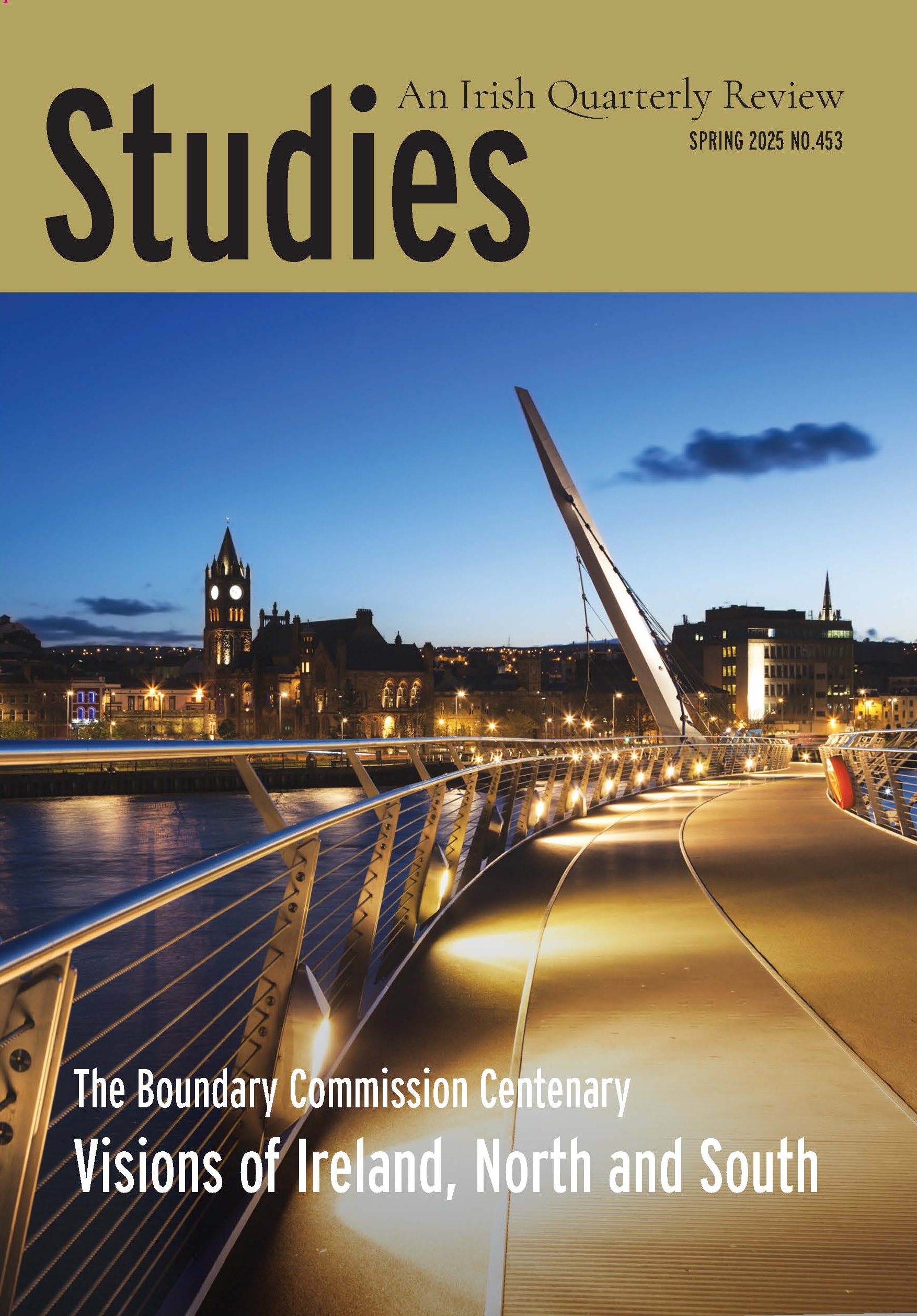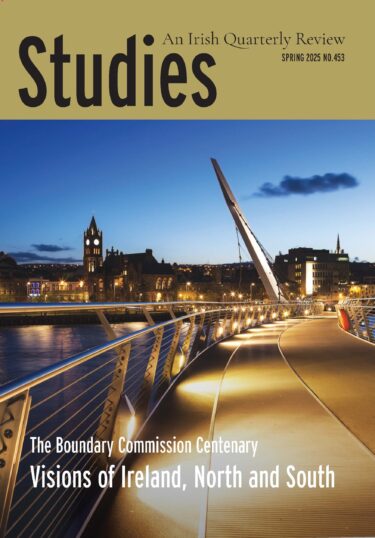Showing 1–12 of 15 results
The Boundary Commission Centenary: Spring 2025, Volume 114, No 453

Full Issue
€10.00+p&p
All the catastrophes that befall King Lear begin with his partitioning of a kingdom. Intending to divest himself of ‘cares of state’, Lear calls for a map and proceeds to draw boundary lines across it, dividing it into three portions, one for each of his daughters. Things fall apart then, of course, and he finds himself, at the play’s climax, houseless and all but alone, raging into a great storm against the ingratitude of his daughters. The curse he calls down is intriguing: ‘And thou,...
Read Editorial
All the catastrophes that befall King Lear begin with his partitioning of a kingdom. Intending to divest himself of ‘cares of state’, Lear calls for a map and proceeds to draw boundary lines across it, dividing it into three portions, one for each of his daughters. Things fall apart then, of course, and he finds himself, at the play’s climax, houseless and all but alone, raging into a great storm against the ingratitude of his daughters. The curse he calls down is intriguing: ‘And thou, all-shaking thunder,’ he roars, ‘Strike flat the thick rotundity o’ th’ world’.
What is a map if not the ‘thick rotundity o’ th’ world’ struck flat? It shows you everything – it is, as J. B. Harley has called it in his renowned essay ‘Deconstructing the Map’, a ‘spatial panopticon’ – and yet it shows you very little. It is only when Lear is thrown into the real world of his kingdom, a far cry from the notional world of the map, that he comes to a concrete understanding of justice, gains empathy with the poor, and perceives the illusions of power and authority.
If twentieth-century decolonisation has taught us anything, it is that having one’s country reduced by administrators to a mere map is often indeed a calamitous curse. So many of the architects of the states that gained independence since the First World War did most of their work in the map room and so had no Lear-like illumination. The brutal conflict between India and Pakistan over Kashmir, the Biafran War in Nigeria, the Rwandan genocide, the Sudanese civil wars, the oppression of the Kurds, and of course the Israeli-Palestinian conflict – all of these bear terrible witness to what has been termed ‘the colonial legacy of artificial borders’. They demonstrate the tendency of empires to disregard the ‘thick rotundity’ of the region they administer, the three-dimensional, textured lifeworld of its inhabitants, with its deep history, diverse traditions and cultures, and complex social divisions. When the empire leaves, then, conflict is inevitable.
The more contested borders or partitions are, the more likely it is that conflict will be addressed primarily from the perspective of reasons of state. Sovereignty, national security, and geopolitical interests will occupy the foreground, and little regard will be shown for the complex identities, experiences, and aspirations of the inhabitants. But what we have seen in India, Africa and the Middle East – indeed what we are seeing now in Israel and Ukraine – is that reasons of state rarely produce long-lasting solutions. They do little to address historical grievances or to defuse cultural anxieties, and they often exacerbate them. For a solution to last, these top-down considerations have to be aligned with close attentiveness to realities on the ground floor. The common good must come first. Plenty of bottom-up approaches present themselves: citizen-led dialogue, trust-building initiatives, the sharing of historical narratives, exercises in restorative justice, and so on. But in all this it may be necessary to hold out against a state-centric logic, which tends to be zero-sum – one side must lose for the other side to win. Especially where minority populations are impacted, it is essential, even if it lengthens the process, to ensure the protection of cultural identities, as well as to consider options such as devolution, dual identity, phased transitions, legal guarantees, and symbolic gestures of inclusion. What paying such close attention to the lives of those affected by boundary issues tends to do, given the ineffable complexities of communal living, is to undermine certainties about how conflicts should be resolved and to slow things down, keeping open the possibility of novel or counter-intuitive solutions. Perhaps there’s a general rule of life here: the more attentive one is, the more tentative one will be. And that’s a good thing.
***
The Irish government’s Decade of Centenaries programme ran from 2012, commemorating the Third Home Rule Bill of April 1912, to 2023, marking the centenary of the Irish Free State’s admission to the League of Nations in September 1923. The intention was of course to cover all the major events in the foundational period of the state – the Ulster Covenant, the Dublin Lockout, the founding of the Irish Volunteers, the Easter Rising, the Anglo-Irish Treaty, and so on – and public events during the commemorative decade did so effectively. It must be said, however, that the foundational period extended beyond 1923. Surely it also includes the Boundary Commission debacle of 1924–5, which locked the partition of Ireland into the 26/6 county division, an outcome that led inexorably to civil strife and the bloody sectarian violence of the Troubles. This failure must be commemorated too.
The brief of the commissioners, according to Article 12 of the Anglo-Irish Treaty, was to revise the border between North and South ‘in accordance with the wishes of the inhabitants, so far as may be compatible with economic and geographic conditions’. But each of the terms in this mandate turned out to be problematic, and without doubt other considerations – reasons of state – came into play. When the commission’s report was eventually suppressed, it brought to a dismal end the Irish republican hope that the treaty would give the nascent state (in the words of Michael Collins) ‘not the ultimate freedom that all nations desire and develop to, but the freedom to achieve it’.
Republican and unionist visions of Ireland, as well as senses of Irishness that are indifferent to centuries-old history, have taken new and more complex shapes in recent decades. This for many reasons – demographic shifts, more complex models of international shared sovereignty, historical distance, and growing disparities between the social and economic fortunes of the two parts of the island, for instance. It remains, therefore, a necessary exercise to reflect again on ‘the wishes of the inhabitants’ of the whole island – to ask ourselves how we see things now, what values we consider paramount, and what actions we believe are needed. The essays in this commemorative issue of Studies contribute to this examination.
In the opening essay, An Taoiseach Micheál Martin remembers Seamus Mallon, just months before his death, saying, ‘When are we going to realise we have to learn to share this place?’ It was Martin’s reflections on this question that led to the Shared Island Initiative, which he launched in 2020 in order ‘to enhance co-operation, connection, and mutual understanding on the island of Ireland’ and ‘to engage with all communities and traditions to build consensus around a shared future’. ‘Real unity’, he concludes, ‘requires genuine respect, which in turn requires genuine reconciliation.’
The following two essays chart the events between the Anglo-Irish Treaty and the suppression of the Boundary Commission report in December 1925. Cormac Moore identifies the weaknesses inherent in Article 12 of the Anglo-Irish Treaty and how these were exploited by the commission chairman, Richard Feetham, so that the outcome would be favourable to Northern Ireland. Ted Hallett, in his essay on ‘Why the Commission Failed to Produce Expected Gains’, also points the finger at Feetham, whose interpretation of Article 12 did not preclude the possibility of Southern territory being awarded to the North, in direct contradiction of the Free State’s assumptions. The root cause of the debacle, it appears, lay with the deliberate ambiguousness of Article 12 itself.
In ‘European Integration and Ireland’s Place in an Evolving European Union’, Paschal Donohoe directs attention to Ireland’s historical orientation towards Europe, dating even back as far as the Carolingian Renaissance and extending to the country’s profoundly positive engagement with the European Union in recent decades. The EU, Donohoe notes, was ‘built through centrist compromise’, and it is this attitude which conveys the importance of openness, tolerance, and consent in the debate about the future of the island of Ireland.
Jane Ohlmeyer, in ‘Visions of Ireland, North and South: An Historical Perspective’, considers Ireland’s experience as ‘the first English colony’. She examines the difficulties met in recent times in situating Ireland within a colonial framework, noting the positive development that there has been a shift from invoking a single political master-narrative in favour of embracing multiple narratives, drawing on various disciplines. The centenary commemorations, Ohlmeyer observes, have forced ‘a fundamental re-examination of our history, how we remember, and how we forget’.
In ‘Irish Unity: Some Societal Consequences’, John Coakley asks, now that the future of partition is back on the political agenda, what models of unity are available and what shape the structural, cultural, and material dimensions of these models would take. The most likely instigator of Irish unity, Coakley judges, is that British policy makers would choose to divest themselves of a troublesome province, at which point, he adds, devising a new constitutional order would only be the start of the project.
For John FitzGerald, it would be unwise to seek referenda on unification on both sides of the border in the foreseeable future. In ‘Narrowing the Gap between the Economies on the Island’, he argues that the economic and social consequences of unification could be very costly for the Republic. A Southern poll could easily reject such a proposal. Major policy reforms in Northern Ireland are needed, he insists, so as to make theirs a fairer society and to reduce the costs that unification would entail.
Joseph Ruane and Jennifer Todd examine the changing forms of national identity in Ireland and their political significance in ‘Contested Categories, Changing Meanings and Identity Disjunctures on the Island of Ireland’. They contend that even though there is an acknowledgement of the need to accommodate different identities and traditions in any future political system on the island, a problem of misrecognition remains. Unionism, in particular, is not the single, monolithic entity that Southerners often suppose it is, and the failure to appreciate the divisions in unionism and its evolving nature poses a serious problem in discourse relating to the future of governance on the island.
Brian Feeney, in ‘The Good Friday Agreement and the Road to Self-Determination’, holds that the Boundary Commission was a charade from the first. From the 1970s on, however, the British have accepted, often reluctantly, that what happens in the North is not exclusively a domestic UK issue. The Republic has a claim to involvement. The end result of this change of view was the Good Friday Agreement in 1998, which has effectively overturned the 1921 Anglo-Irish Treaty and once again presents republicans with ‘the freedom to achieve freedom’.
In ‘A Century on and the Fear of a Boundary Commission Has Been Replaced by the Fear of a Border Poll’, Alex Kane looks at unionist fears both as they took shape in the context of the Boundary Commission and as they have re-emerged in the wake of the Northern Ireland Protocol. In both instances, unionists have been given reason to believe that British governments ignore or undermine them and treat the North differently from any other section of the United Kingdom. The prospect of a border poll now casts a dark shadow across the unionist horizon.
Almost sixty years after the Boundary Commission, Margaret Thatcher raised the question of resurrecting it, in her negotiations with Garret FitzGerald during the long lead-up to the Anglo-Irish Agreement of 1985. She wondered if the Irish border could be redrawn so as to exclude predominantly Catholic areas. Stephen Collins recounts the details of this extraordinary postscript to the history of the commission in ‘The Boundary Commission Revisited: The Thatcher–FitzGerald Talks’.
In ‘After Good Friday: Learning from Experience and Evolving Identity’, Seamus Murphy SJ recapitulates the argument of his recent book on confronting Ireland’s past. He argues that many of the features of nationalist and unionist culture during the foundational phase of the new Irish state – suspicion of democratic politics, the formation of armed militias, the refusal to accept a plurality of identities, resistance to reconciliation – were responsible for the dysfunctional politics of later decades. The principles of the Good Friday Agreement, he holds, ‘offer a new start, a new hope’.
The set of essays of visions of Ireland concludes with a review article by
Brian Murphy on Stephen Collins’ Ireland’s Call: How Brexit Got Done, a behind-the-scenes account of how Irish politicians navigated the turbulent waters of Brexit both before and after the 2016 British referendum. Murphy commends Collins for the clarity and depth with which he chronicles ‘the diplomatic struggles, political intrigue, and personal dynamics that shaped the Brexit saga’.
Apart from the set of essays addressing the central theme of ‘Visions of Ireland’, there are two further contributions in this issue of Studies. Poems by Irish poet Ciarán O’Rourke bear lyrical witness to brutal death – the death of Refaat Alareer, the Palestinian writer and academic who was killed in an Israeli airstrike in December 2023, and (inspired by a Caravaggio painting) that of St Peter nailed to a cross. A third poem, adapted from an account by a sixteenth-century Jesuit priest, José de Acosta, presents a harrowing vision of the deadly greed of Spanish adventurers in the Andean silver mines.
The second piece is a lengthy personal reflection by Patrick Nolan on the monumental work of Iain McGilchrist, The Matter with Things: Our Brains, Our Delusions, and the Unmaking of the World. McGilchrist’s central thesis is that we tend to prioritise the brain’s left hemisphere, the side of the brain that seeks to manipulate the world rather than to understand it holistically and to learn how to relate to it, which is the work of the right hemisphere. Nolan sees this as consistent with both the psychological perspective of St Ignatius Loyola and the methodology of Action Research. Reading McGilchrist has been, for him, a lengthy journey of inquiry and discovery.

